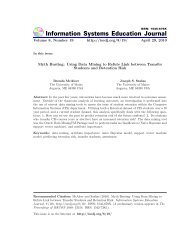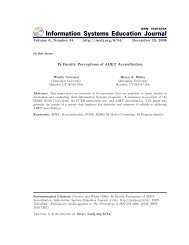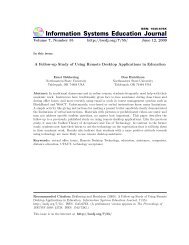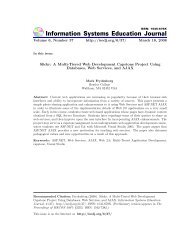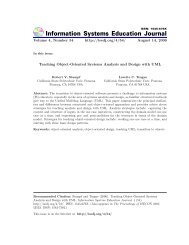Teaching Relational Algebra and Relational Calculus: A ...
Teaching Relational Algebra and Relational Calculus: A ...
Teaching Relational Algebra and Relational Calculus: A ...
Create successful ePaper yourself
Turn your PDF publications into a flip-book with our unique Google optimized e-Paper software.
ISEDJ 6 (9) McMaster, Anderson, <strong>and</strong> Blake 4<br />
elty of Really <strong>Teaching</strong> Computer Science"<br />
(1998), suggested that students learn best<br />
by writing code <strong>and</strong> verifying it solely<br />
through formal methods. Database textbooks<br />
unwittingly support this approach in<br />
their coverage of RA <strong>and</strong> RC, since no environment<br />
is provided for students to execute<br />
RA <strong>and</strong> RC query programs.<br />
This is in contrast to most programming<br />
courses, where an important part of learning<br />
depends on students being able to see the<br />
effects of their code as it executes. To demonstrate<br />
how a computer implementation<br />
differs from a mathematical model, students<br />
need to have software available to experiment<br />
with <strong>and</strong> observe how it behaves. Students<br />
learn mathematics <strong>and</strong> computer concepts<br />
more effectively when they can work<br />
with actual computer representations. This<br />
is particularly true when we teach students<br />
how to query using RA <strong>and</strong> RC.<br />
Unfortunately, few computer implementations<br />
are available for RA <strong>and</strong> RC. <strong>Relational</strong><br />
database products offer SQL as the primary<br />
query language. Some form of Query-By-<br />
Example is included with desktop database<br />
programs. One of the few database products<br />
to offer RA as a query language is the<br />
LEAP RDBMS (Leyton, 2005). Also, since RC<br />
is a form of predicate calculus, some Prolog<br />
compilers can be used to approximate RC<br />
queries.<br />
In this paper, we will show how to write <strong>and</strong><br />
execute RA <strong>and</strong> RC query programs. For RA<br />
queries, instead of using the LEAP RDBMS,<br />
we prefer to use a special RA function library<br />
that we have developed for the Visual Fox-<br />
Pro environment. For RC queries, we utilize<br />
predicate calculus features in the Turbo<br />
Prolog compiler.<br />
2. WHY TEACH RELATIONAL ALGEBRA<br />
AND RELATIONAL CALCULUS?<br />
The question might arise: Do we need to<br />
teach RA <strong>and</strong> RC in a database course? We<br />
often hear the statement: "Students only<br />
need to learn SQL." Robbert <strong>and</strong> Ricardo<br />
(2003) presented a paper in 2003 entitled<br />
"Trends in the Evolution of the Database<br />
Curriculum." The authors conducted surveys<br />
of database educators in 1999, 2001, <strong>and</strong><br />
2002, asking them which topics are included<br />
in their database courses. For the 106 respondents<br />
in the 2001 survey, 92% said<br />
they covered SQL, 70% included RA, but<br />
only 42% mentioned RC. Apparently, many<br />
database educators do not feel that RA <strong>and</strong><br />
RC are essential topics in their courses.<br />
We believe otherwise. <strong>Teaching</strong> SQL is a<br />
major part of a database course, but coverage<br />
of RA <strong>and</strong> RC is also important. There<br />
are several reasons for this:<br />
1. RA provides the relational model with a<br />
flexible way to query a database. The<br />
RA operations allow specific rows <strong>and</strong><br />
columns from a single table to be chosen<br />
to obtain the desired data. The RA operations<br />
also define how the data in<br />
separate tables can be combined both<br />
horizontally <strong>and</strong> vertically as needed for<br />
a query.<br />
2. Knowledge of RA facilitates learning <strong>and</strong><br />
using SQL as a query language. The basic<br />
syntax of the SQL SELECT statement<br />
provides a simple framework for combining<br />
RA operations to express a query.<br />
When writing an SQL query statement, it<br />
helps to think in terms of the RA operations<br />
needed to retrieve data from the<br />
database.<br />
3. The query processor component of the<br />
DBMS engine translates SQL code into a<br />
query plan that includes RA operations.<br />
Anyone who writes DBMS query processing<br />
software or needs to optimize SQL<br />
query execution will benefit from an underst<strong>and</strong>ing<br />
of RA.<br />
4. Codd's first database paper "A <strong>Relational</strong><br />
Model of Data for Large Shared Data<br />
Banks" (1970) did not mention RA, but it<br />
did suggest the use of predicate calculus<br />
(the basis for RC) as a query language.<br />
RA was introduced in later papers.<br />
5. RC is the foundation for Query-By-<br />
Example, which provides a user-friendly<br />
interface for databases.<br />
6. Predicate calculus (<strong>and</strong> RC) can be used<br />
to develop an intelligent front-end for a<br />
database (e.g. an expert system).<br />
7. Learning RA <strong>and</strong> RC makes a student<br />
aware of conceptual <strong>and</strong> practical differences<br />
between procedural <strong>and</strong> nonprocedural<br />
query languages.<br />
If coverage of RA <strong>and</strong> RC in a database<br />
course is considered to be important, the<br />
next issue is how to provide this coverage.<br />
c○ 2008 EDSIG http://isedj.org/6/9/ February 7, 2008



